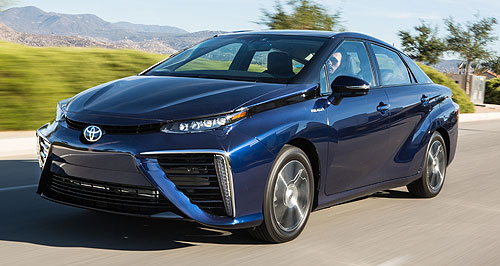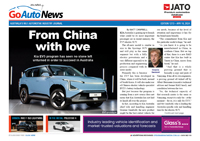Make / Model Search
Future models - Toyota - MiraiMirai heralds Toyota’s fuel-cell techFuture proof: Mirai is set to go on sale in Toyota’s Japanese home market next month, but it has been ruled out for Australia. Toyota’s Mirai fuel-cell vehicle offers 500km cruising range, emitting water vapourGallery Click to see larger images 19 Nov 2014 TOYOTA has confirmed details of its production-ready hydrogen fuel-cell-powered Mirai sedan ahead of its roll-out in some markets, but Australia is unlikely to get the revolutionary green machine any time soon. Previewed by the FCV concept from last year’s Tokyo motor show, Mirai uses the Toyota Fuel-Cell System (TFCS) that combines fuel-cell and hybrid technology to emit nothing but water vapour from the exhaust. Mirai will go on sale in Japan this month ahead of the United States and Europe next year, but Toyota Motor Corporation Australia product public relations manager Steve Coughlan told GoAuto that it is an unlikely starter in Australia due to a lack of infrastructure. “The new Toyota Mirai is an amazing and ground breaking vehicle, showcasing Toyota's on-going pursuit to remain at the forefront of sustainable mobility whilst building ever-better cars,” he said. “I can confirm, however, that we currently have no plans to sell fuel cell vehicles in Australia.” Mr Coughlan said Toyota Australia would reconsider its decision if sufficient consumer demand for hydrogen fuel-cell vehicles arose, but he added that there were many barriers to this. “Our goal, as always, is to deliver the right product at the right time to meet the needs of Australian consumers,” he said. “As such, we are always reviewing our future model line-up. “If sufficient local demand for hydrogen fuel-cell vehicles develops in the future, this is something we can certainly explore further. “However, in this instance Australia also needs to have the relevant infrastructure in place before these vehicles can be sold commercially.” While Toyota Australia is not involved in discussions with the federal government or infrastructure providers to push the case for hydrogen fuel-cell technology, Mr Coughlan said government support would be required to make it viable. “However, it is a fact that any country in the world would need the support of government and the relevant providers to develop hydrogen refuelling infrastructure,” he said. Toyota global president Akio Toyoda said technology in the Mirai – which means future in Japanese – would help reduce people’s reliance on oil and therefore benefit the environment. “The future has arrived – and it's called Mirai," he said. “We imagined a world filled with vehicles that would diminish our dependence on oil and reduce harm to the environment. It was a bold, but inspiring goal – and today it is a reality. “Our fuel cell vehicle runs on hydrogen that can be made from virtually anything, even garbage. It has a fuel cell that creates enough electricity to power a house for about a week. “This is a car that lets you have it all with no compromises."Toyota’s fuel-cell stack produces 114kW of power and has a volume power density of 3.1kW/litre. The hydrogen is stored in two high-pressure tanks with a combined volume of 122.4 litres at 700 bar (10,000psi), which then feeds into the fuel-cell stack where it combines with oxygen to create a chemical reaction to produce electricity to power the Mirai via a 113kW/335Nm electric motor. The power is stored in a nickel-metal hydride battery. No CO2 emissions are produced from the car, which Toyota says is more energy efficient than a regular internal combustion engine. According to the Japanese giant, the Mirai offers a cruising range of about 500km and takes about three minutes to refuel under SAE standard fuelling conditions. The Mirai is 4890mm long, 1815mm wide, 1535mm high and has a 2780mm wheelbase. This makes it 75mm longer and 65mm higher with a 5mm-longer wheelbase than the mid-size Camry, although the latter is 10mm wider. Toyota describes the unusual exterior styling as “easily recognisable” with its “novel face” featuring two massive triangular air intakes flanking a more sedate centre intake that draws in air for the fuel-cell system cooling and “ultra-thin” LED headlight design. Toyota describes the side lines of the Mirai as evoking the “flowing shape of a droplet of water”, highlighting its ability to draw in air and emit water. The Mirai’s unique rear-end styling incorporates a similar triangular theme to the front, while the boot features a trapezoidal cut-out surrounding the registration plate housing. The fuel-cell stack and hydrogen tanks are housed under the floor in the centre of the vehicle, which the company says helps achieve a low centre of gravity and even weight distribution. A full under-floor cover and aerodynamically designed clearance lights help reduce wind resistance and improve fuel efficiency. Sound-blocking and absorbing materials have been used in and around the cabin, as well as noise-reducing glass for “outstanding” quietness at any speed. Toyota offers a choice of six body colours, and the Mirai rides on 17-inch aluminium wheels. Inside, a central cluster at the top of the instrument panel includes a speedo and multi-information display with a 4.2-inch high-definition TFT display. The Mirai also has eight-way power adjustable front seats, a flat panel display for the dual-zone air-conditioning display, heated seats and a heated steering wheel. Toyota has included a number of measures to assist “in the unlikely event that any leaks do occur” in the hydrogen tanks. Hydrogen sensors can provide warnings and shut off the tanks main stop valves, and the tanks are located outside the cabin, meaning the hydrogen should dissipate easily. The tanks also feature hydrogen permeation prevention. Other active safety features include a pre-collision warning and braking system, lane-departure alert, blind-spot monitor and a “dive-start control system” that limits sudden acceleration or starts during gear-shift operation. Earlier this year, Toyota confirmed the Mirai would go on sale in Japan for ¥7 million ($A68,700).  Read more25th of June 2014  First look: Toyota shows fuel-cell car for the roadToyota set to take the hydrogen route with fuel-cell sedan – but no time soon on OzAll future models Alfa Romeo Alfa Romeo Abarth Abarth Alpine Alpine Alpina Alpina Audi Audi Aston Martin Aston Martin BMW BMW Bentley Bentley Chery Chery Brabham Brabham Chrysler Chrysler Chevrolet Chevrolet Cupra Cupra Citroen Citroen DS DS Dodge Dodge Fiat Fiat Ferrari Ferrari Foton Foton Ford Ford Great Wall Great Wall FPV FPV Haval Haval GWM GWM Honda Honda Holden Holden Hummer Hummer HSV HSV Infiniti Infiniti Hyundai Hyundai Jaguar Jaguar Isuzu Isuzu Kia Kia Jeep Jeep Land Rover Land Rover Lamborghini Lamborghini Lexus Lexus LDV LDV Mahindra Mahindra Lotus Lotus Mazda Mazda Maserati Maserati Mercedes-AMG Mercedes-AMG McLaren McLaren MG MG Mercedes-Benz Mercedes-Benz Mitsubishi Mitsubishi Mini Mini Opel Opel Nissan Nissan Peugeot Peugeot Pagani Pagani Proton Proton Porsche Porsche Renault Renault Ram Ram Rover Rover Rolls-Royce Rolls-Royce Skoda Skoda Saab Saab SsangYong SsangYong Smart Smart Suzuki Suzuki Subaru Subaru Toyota Toyota Tesla Tesla Volvo VolvoMotor industry news |
Click to shareToyota modelsResearch Toyota All future models Alfa Romeo Alfa Romeo Abarth Abarth Alpine Alpine Alpina Alpina Audi Audi Aston Martin Aston Martin BMW BMW Bentley Bentley Chery Chery Brabham Brabham Chrysler Chrysler Chevrolet Chevrolet Cupra Cupra Citroen Citroen DS DS Dodge Dodge Fiat Fiat Ferrari Ferrari Foton Foton Ford Ford Great Wall Great Wall FPV FPV Haval Haval GWM GWM Honda Honda Holden Holden Hummer Hummer HSV HSV Infiniti Infiniti Hyundai Hyundai Jaguar Jaguar Isuzu Isuzu Kia Kia Jeep Jeep Land Rover Land Rover Lamborghini Lamborghini Lexus Lexus LDV LDV Mahindra Mahindra Lotus Lotus Mazda Mazda Maserati Maserati Mercedes-AMG Mercedes-AMG McLaren McLaren MG MG Mercedes-Benz Mercedes-Benz Mitsubishi Mitsubishi Mini Mini Opel Opel Nissan Nissan Peugeot Peugeot Pagani Pagani Proton Proton Porsche Porsche Renault Renault Ram Ram Rover Rover Rolls-Royce Rolls-Royce Skoda Skoda Saab Saab SsangYong SsangYong Smart Smart Suzuki Suzuki Subaru Subaru Toyota Toyota Tesla Tesla Volvo VolvoMotor industry news |























Facebook Twitter Instagram